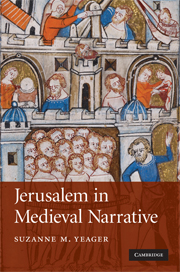Book contents
- Frontmatter
- Contents
- Acknowledgments
- List of abbreviations
- Introduction: texts and contexts
- 1 Pilgrimage to Jerusalem: three accounts by English authors
- 2 Craving heritage: portrayals of Richard I and the English quest for Jerusalem in Richard, Coer de Lyon
- 3 The crusade of the soul in The Siege of Jerusalem
- 4 The Book of Sir John Mandeville: text of pilgrimage and spiritual reform
- 5 Beyond the Celestial and Terrestrial Jerusalem: the Promised Land in western Christendom
- Conclusion
- Notes
- Bibliography
- Index
- CAMBRIDGE STUDIES IN MEDIEVAL LITERATURE
3 - The crusade of the soul in The Siege of Jerusalem
Published online by Cambridge University Press: 22 September 2009
- Frontmatter
- Contents
- Acknowledgments
- List of abbreviations
- Introduction: texts and contexts
- 1 Pilgrimage to Jerusalem: three accounts by English authors
- 2 Craving heritage: portrayals of Richard I and the English quest for Jerusalem in Richard, Coer de Lyon
- 3 The crusade of the soul in The Siege of Jerusalem
- 4 The Book of Sir John Mandeville: text of pilgrimage and spiritual reform
- 5 Beyond the Celestial and Terrestrial Jerusalem: the Promised Land in western Christendom
- Conclusion
- Notes
- Bibliography
- Index
- CAMBRIDGE STUDIES IN MEDIEVAL LITERATURE
Summary
Like Richard, Coer de Lyon, the Middle English romance, The Siege of Jerusalem, positions the control of the holy city as an expression of earthly power and as irrefutable proof of divine favor. However, while both late medieval texts seem to agree on the associative might that this city confers, the poetic Siege of Jerusalem (Siege, hereafter) depicts a destructible Jerusalem that may be divested of its powers. In the poem, Jerusalem is no longer both relic and reliquary, it is rather, as Christine Chism has described it, a “town-sized treasure chest” to be ransacked, with its symbols of sacred identity, such as the Veil of Veronica and the Temple Menorah, stolen away, piece by piece. Through this and other portrayals, the anonymous writer of the Siege presents the reader with a city whose sacred essence is transferable, thereby representing a different version of the many Jerusalems that existed in the late medieval English imaginary. Adding to the perceptions of the holy city as spiritual testing ground and mnemonic device, as seen in the pilgrim texts, or as symbol of authority and divine support, as seen in the Richard romance, the Siege offers Jersualems both perishable and transcendent, and both literal and exegetical. The actual city of the poem is destroyed by the Romans, referencing a very real event in Jerusalem's history, but also suggesting that city's place in a continuous cycle of destruction and rebirth.
- Type
- Chapter
- Information
- Jerusalem in Medieval Narrative , pp. 78 - 107Publisher: Cambridge University PressPrint publication year: 2008

